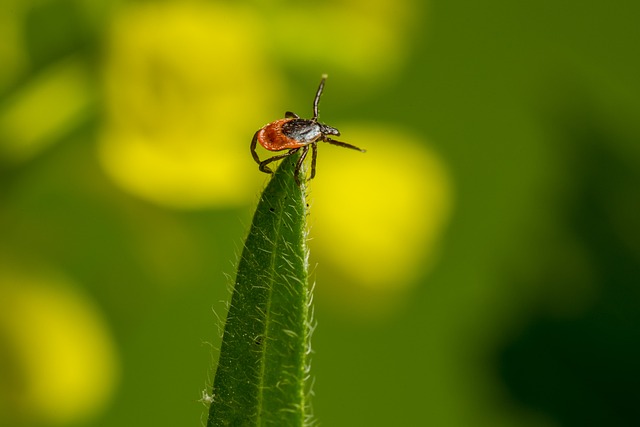Understanding tick safety involves recognizing their preferred habitats and the health risks they pose. Effective tick control requires tailored strategies like landscape modifications, regular lawn care, and eco-friendly repellents or treatments. Customized tick control plans, based on environmental factors, use natural repellents, plant barriers, and organic pesticides to minimize ecological disruption while protecting against tick-borne diseases. Regular monitoring with traps or hand checks ensures the safety of individuals and pets in high-risk areas like brushy vegetation and wooden structures, promoting a healthier environment free from ticks.
In the pursuit of outdoor enjoyment, understanding tick safety and their habitat is paramount. Ticks pose significant health risks, but embracing eco-friendly solutions offers a sustainable approach to removal without harmful chemicals. This article explores traditional versus eco-friendly tick removal methods, emphasizing the importance of tailored, customized tick control plans for effective, safe, and environmentally conscious prevention. Learn how to design, implement, and monitor these plans for optimal protection.
Understanding Tick Safety and Their Habitat
Understanding Tick Safety and Their Habitat
Ticks are tiny parasitic arachnids that pose a significant health risk to both humans and animals, primarily due to their ability to transmit diseases like Lyme disease, Rocky Mountain spotted fever, and Anaplasmosis. These creatures thrive in specific habitats, often found in lush vegetation, tall grass, and dense forests, making them more prevalent in outdoor environments. Recognizing their preferred ecosystems is crucial for implementing effective tick control measures. Customized tick control plans tailored to these habitats involve a combination of strategies such as landscape modifications, regular lawn care, and the use of repellents or treatments recommended by professionals.
By understanding where ticks are most likely to be found, homeowners, outdoor enthusiasts, and pet owners can proactively reduce their exposure and that of their loved ones and pets. This approach not only emphasizes the importance of prevention but also paves the way for safer and more eco-friendly removal methods when necessary, ensuring a healthier balance between humans, animals, and the natural environment.
Traditional vs Eco-Friendly Tick Removal Methods
In the realm of tick removal, traditional methods often involve chemical-laden solutions that can have adverse effects on both human health and the environment. These include topical treatments, sprays, and repellents containing synthetic ingredients. In contrast, eco-friendly approaches prioritize natural, non-toxic alternatives for safe and effective tick control. By opting for these methods, individuals and communities can minimize environmental impact while protecting against tick-borne diseases.
Eco-friendly tick removal encompasses a range of strategies, from customized tick control plans tailored to specific ecosystems and habitats to the use of natural repellents like essential oils and plant-based formulations. These solutions not only reduce the risk of exposure to harmful chemicals but also foster a more harmonious relationship with nature. By adopting these practices, folks can effectively manage tick populations while preserving biodiversity and maintaining the integrity of their surroundings.
Designing a Customized Tick Control Plan
When creating an eco-friendly approach to tick removal, designing a customized tick control plan is essential. This strategy involves understanding your specific environment and the unique challenges it presents for tick management. By assessing factors like vegetation type, climate, and local wildlife, you can tailor solutions that are both effective and sustainable. For instance, using natural repellents like citrus oils or creating physical barriers with certain plants known to deter ticks can significantly reduce their presence in your outdoor spaces.
Customized tick control plans also encourage the responsible use of organic pesticides when necessary. Targeted applications of these products can help eliminate ticks without causing harm to non-target species, including beneficial insects and wildlife. Regular monitoring and maintenance are key components of such a plan, ensuring that tick populations remain under control while minimizing ecological disruption.
Implementing and Monitoring the Plan Effectively
Implementing and monitoring a customized tick control plan is key to effective prevention and safe removal. This involves identifying high-risk areas in your yard or outdoor space, such as brushy vegetation and wooden structures, which serve as ideal habitats for ticks. Regularly maintain these areas by mowing grass, raking leaves, and trimming branches to reduce shelter and food sources for ticks.
Additionally, consider using natural repellents like essential oils (e.g., lemon eucalyptus) or applying organic treatments specifically designed for tick control. Regular monitoring with tools like tick traps or conducting hand checks after outdoor activities can help detect any present ticks early on. This proactive approach ensures the safety of individuals and pets while enjoying nature and promotes a healthier environment free from these pesky vectors.
In light of the above discussions, it’s clear that adopting eco-friendly solutions for tick removal is both effective and responsible. By understanding tick habitat and safety, utilizing natural methods, and designing tailored customized tick control plans, individuals can protect themselves and their environments from these pests. Regular monitoring and adjustments to these plans ensure ongoing effectiveness, fostering a safer, more harmonious relationship with nature.
